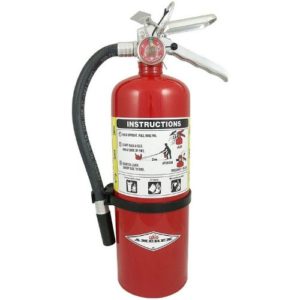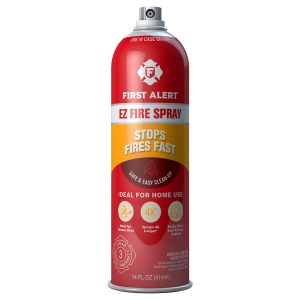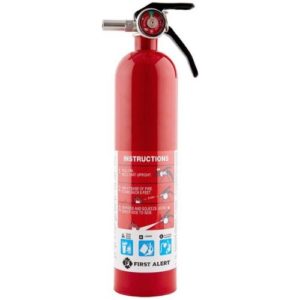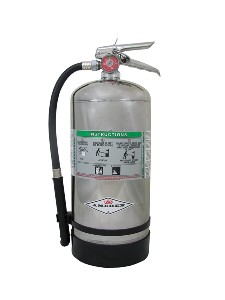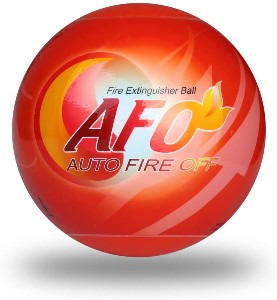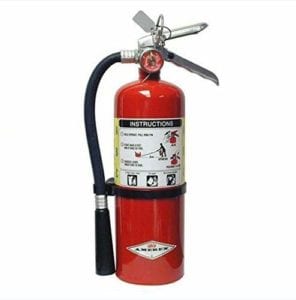Best Fire Extinguishers
When we started researching the best fire extinguishers for our fire safety guide, we talked to Henrico County firefighter Sarah Hill. Right away, she recommended the Amerex brand. When asked why it was her top pick, she said, "Reliable. It's what we use."
We found that it's one of the most recommended fire extinguishers on the market, and its steel casing and aluminum valves make it durable enough to withstand a fire and be recharged for future use.
Here's more about Amerex and our other top picks for extinguishing a grease fire, electrical fire, fires with ordinary combustibles, and more.
Best fire extinguishers
- : Best for reliability
- : Best for portability
- : Budget pick
- : Best for kitchen fires
- : Best automatic extinguisher
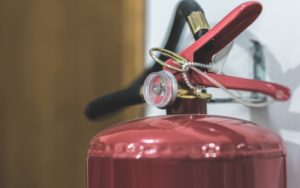
Compare fire extinguishers
*Amazon.com price as of post date. Offers and availability may vary by location and are subject to change. Read full disclaimer.
See also:
Best fire extinguisher reviews
1. Amerex B402: Best for reliability
*Amazon.com price as of post date. Offers and availability may vary by location and are subject to change. Read full disclaimer.
If you want a heavy-duty, definitely-going-to-do-the-job fire extinguisher, then Amerex extinguishers are your best bet. The firefighter we talked to gave them top marks for reliability and effectiveness.
Reliable performance for A, B, C fires
The Amerex B402 is a dry chemical fire extinguisher certified for class A, B, and C fires, and it discharges for 14 seconds. One Amazon reviewer said that a home Amerex extinguisher that was last inspected in 1998 successfully put out a fire in his house in 2019.
While we don't recommend letting your fire extinguishers go without maintenance for that long, it's definitely proof that Amerex extinguishers are reliable.
Amerex fire extinguisher is powerful but messy
We chose the B402 for our recommendation because it contains a manageable amount of dry powder (five pounds), and the extinguisher's solid steel casing brings its weight up to nearly 10 pounds. It releases a forceful dry chemical cloud to swallow fires fast, but testers say that the cloud is also enough to swallow the person spraying it, driving them from the room. The spray also leaves a substantial mess behind.
Amerex extinguishers are fully rechargeable, which is nice, since they're the priciest fire extinguishers on our list. But we recommend double-checking the tamper seal and the pressure gauge if you buy your Amerex on Amazon, as Amazon customers report receiving recharged extinguishers with broken seals or without a full charge.
Small fires only, please. For your safety, never attempt to use a fire extinguisher to put out a fire that is larger than an office-sized trash can. Fires double in size every 30 seconds, and once a fire gets taller than the space between your feet and your knees, it can get out of hand much quicker than you might expect.
Rather than trying to put it out, immediately exit the home or get a safe distance away from the fire and call 911.
2. First Alert EZ Fire Spray: Portable pick
*Amazon.com price as of post date. Offers and availability may vary by location and are subject to change. Read full disclaimer.
The First Alert EZ Spray (formerly known as Tundra) is our portable fire extinguisher pick because it's the size of a spray can. It's perfect for keeping in your car, but it got bumped down lower on our list because it doesn't have the easy-to-use trigger nozzle. You have to press down pretty hard to get it to spray, but when it does, it covers a wide area.
Good for extinguishing kitchen fires
This portable fire extinguisher is also nontoxic, and its extinguishing agent leaves a dry residue that you can wipe up easily. It's rated for class A, B, C, and K fires, so it's great to keep in the kitchen. You'll want to keep a bigger Class K fire extinguisher like the Amerex B260 in the kitchen too, just in case the EZ Fire Spray runs out before the fire goes out completely.
The First Alert EZ Fire Spray has been tested to the qualified performance requirements of UL 711, UL 711A and KOFEIC 0108 by an independent nationally recognized testing laboratory (NRTL). It's important to note, though, that this product isn't called a fire extinguisher. Instead, it's called an extinguishing spray.
Replace this spray after one use
We would recommend keeping this in your kitchen for small flare-ups, but keep a full-size fire extinguisher on hand too. Also, since this product doesn't have a gauge, be sure to only use it once and then replace it, and don't use it past its expiration date.
3. First Alert Standard Home Fire Extinguisher: Best for budget
*Amazon.com price as of post date. Offers and availability may vary by location and are subject to change. Read full disclaimer.
A tight budget should never prevent you from keeping your family safe, which is why we wanted to include the affordable First Alert Standard Home Fire Extinguisher. It costs only around $30, so you can purchase one—or more than one—without breaking the bank.
Rechargeable extinguisher
Despite its low price, the First Alert Standard Home Fire Extinguisher's extinguishing agent is still rated to handle most home fires, including fabric, wood, paper, flammable liquids, and electrical fires. It's rechargeable, but the cost of recharging is high enough and the cost of this extinguisher is low enough that it probably makes sense to just buy a new one after you use it.
Lightweight option
With its aluminum casing, it's not as sturdy as the Amerex, but it's lighter and a more portable extinguisher. It's a good choice if you have kids or older adults in your home who might not be able to lift a heavier extinguisher.
4. Amerex B260: Best for kitchen fires
*Amazon.com price as of post date. Offers and availability may vary by location and are subject to change. Read full disclaimer.
Kitchen fires (Class K fires) require a special extinguishing agent, such as the potassium acetate wet chemical agent in the heavy-duty Amerex B260. This 22-pound behemoth can also be used on basic Class A fires, but shouldn't be used on Class B fires (solvents, gasoline, etc.) or Class C fires (electrical fires).
Expensive but extremely effective extinguisher
Although its price and size might make you think the Amerex B260 is only for commercial kitchens, every home cook should keep this extinguisher handy. The price is typical of Class K extinguishers of this size, and compared to the price of fire damage, this is really a great deal.
As we mentioned earlier, you can keep the First Alert Tundra on hand to nip a small grease fire in the bud, but keep the 6-liter Amerex B260 nearby just in case it blooms into a bigger fire.
5. AFO Fire Ball: Best automatic extinguisher
*Amazon.com price as of post date. Offers and availability may vary by location and are subject to change. Read full disclaimer.
The AFO Fire Ball isn't a typical fire extinguisher. This one-pound powder ball bursts when exposed to flames for two to three seconds, covering an area of 8 cubic feet with fire-smothering agents.
How to use a fire suppression ball
It's considered an "automatic" fire extinguisher because you can place it in areas at high risk of fire for immediate, hands-off suppression. For example, you could place one of these AFO fire balls under the hood for quick protection from a car fire.
Put them where a fire might start, whether it's near the battery charging station in your workshop, near the gasoline storage in your garage, or in an electrical box. The AFO is rated for Class A, B, and C fires only.
You can also throw it into a small fire, but it's a lot easier to aim a hose than it is to hit the mark with a fire ball on the first try. Keep a "traditional" fire extinguisher on hand too.
Fire extinguisher FAQ
Before you purchase a fire extinguisher, it's important to understand the different types of fires. Chemical fire extinguishers are filled with different fire suppressants, and choosing a type of extinguisher with the wrong contents could actually make a fire worse (like throwing water on a grease fire).
Household fires fall under three classifications, depending on the type of fuel burning. The most common fire extinguisher classifications are A, B, C, and K.
- Class A: Solid combustible materials that are not metals, like wood, paper, cloth, plastics, and rubber
- Class B: Flammable liquids, like gasoline, oil, grease, and paints
- Class C: Electrical equipment, like appliances and outlets
- Class K: Cooking oils and greases, animal fats, and vegetable fats
ABC fire extinguishers will handle most household fires, but just to be on the safe side, it's smart to also have a K-rated fire extinguisher on hand for your kitchen.
Once you've selected the best fire extinguishers for your home, placement is important. You might want to store your extinguisher right next to your stove, but fire extinguishers shouldn't be subjected to high temperatures. Also, if your stovetop bursts into flames, you won't want to be near it.
Instead, place fire extinguishers in locations no closer than 5–8 feet from potential fire sources like deep fat fryers, fireplaces, or clothes dryers. This way you can access them quickly and safely in case of a fire. Make sure that there is always a fire extinguisher no farther than 40 feet away from any location in your home.
The National Fire Protection Association (NFPA) recommends installing a fire extinguisher on every floor of your home and having it inspected annually. The US Department of Agriculture (USDA) takes that counsel even further, recommending that you install separate fire extinguishers in your kitchen, garage, basement, and car. Put them in plain view, within easy reach of adults—though out of reach of children—and near an escape route.
After your fire extinguishers are in place, don't just set them and forget them. Make sure everyone in your household knows where they are and how to use them.
Take the time to read their labels, and rehearse the steps you would need to take to operate them in an emergency.
Remember P.A.S.S.:
Pull the pin,
Aim the extinguisher at the base of the fire,
Squeeze the trigger
And Sweep the spray across the base of the fire.
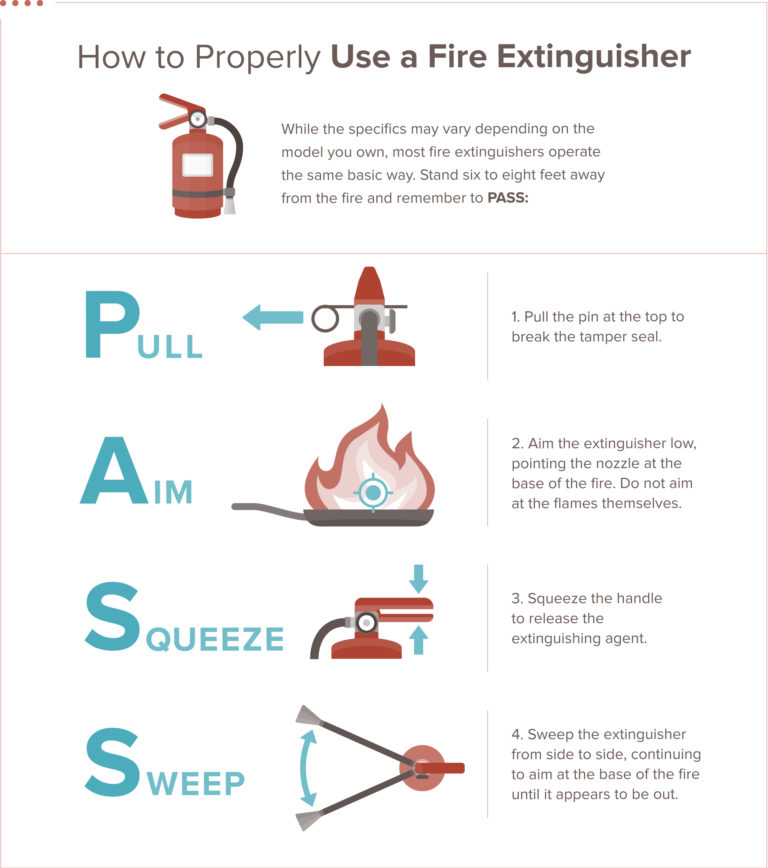
Follow these guidelines for regular maintenance on your fire extinguishers:
- Check the pressure regularly. The pressure gauge needle should be in the green zone. Replace or recharge any extinguishers if the needle is in the red zone.
- Monitor for damage. Make sure the pin and tamper seal are intact. Check for dents, leaks, rust, or other signs of wear.
- Shake it. If you have a dry chemical extinguisher, many manufacturers recommend shaking it monthly so the powder does not settle.
- Get it tested. Get your extinguisher pressure-tested every few years by a professional, as per the manufacturer’s recommendation.
- Recharge. No matter how much (or how little) was used, if you discharged an extinguisher, it needs to be recharged. Your local fire department may offer this service, or you can find a professional recharging company in your area.
- Discard. All disposable extinguishers must be discarded after use.
Remember, with flammable materials, fires can double in size every 30 seconds. A fire the size of a trash can becomes the size of a coffee table in a minute, the size of a sofa in 90 seconds, and flames as big as a full-size bed in two minutes.
You and your fire extinguisher are your first line of defense. It may take firefighters five to 10 minutes or more to reach you, which is more than enough time to lose your home or a life.
Water mist extinguishers are best for class A fires (flammable materials like wood, fabric, and combustible plastic) especially when there's no danger of electrical shock.
Unlike chemical fire extinguishers, water mist extinguishers use a clean agent with no residue so cleanup is easier, but they're less effective on class B and C fires, and may even make them worse.
Carbon dioxide extinguishers (also called CO2 extinguishers) work best for Class B fires and Class C fires (flammable liquid and electrical equipment) because they smother the fire and cool it very quickly with a cold discharge.
Security systems are a smart way to protect your home and family against fire, flood, carbon monoxide poisoning, and of course, intruders.
Professional safety monitoring gives you an extra set of eyes on your home to help you handle emergencies. Incorporating smart products into your security system can help your devices work together, like having your thermostat turn off your home's air circulation system when smoke is detected.
How we picked the best fire extinguishers
To research the best fire extinguishers, we talked to a firefighter to learn from her experience which extinguishers were the most effective at putting out fires and which were most reliable long-term.
We also watched videos of different fire extinguishers in action, read more than 100 reviews from customers about their successes and failures using each extinguisher, and visited manufacturer websites for more information.
Our full methodology explains more about our methods for reviewing consumer products.
Co-authored by Kasey Tross
Related articles on SafeWise
Disclaimers
Product prices and availability are accurate as of the date/time indicated and are subject to change. Any price and availability information displayed on Amazon at the time of purchase will apply to the purchase of this product. Safewise.com utilizes paid Amazon links.
Certain content that appears on this site comes from Amazon. This content is provided “as is” and is subject to change or removal at any time.
Recent Articles




The post Best Fire Extinguishers appeared first on SafeWise.
Article source here: Best Fire Extinguishers
